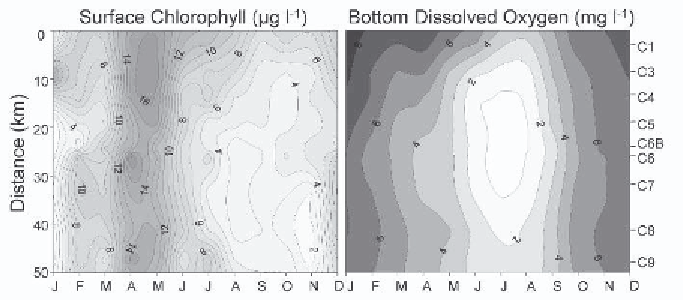Environmental Engineering Reference
In-Depth Information
6- to 10-m water depth as late as November (T. Romaire pers. comm.). Hypoxia
is rare in late fall and winter. The monthly average value of bottom oxygen
concentration along transect C illustrates the seasonal progression of worsen-
ing hypoxia across an increasingly greater area in May through August (Fig.
7). The persistence of extensive and severe hypoxia into September and Oc-
tober depends on the timing of the breakdown of vertical stratification from
either tropical storms, passage of cold fronts or thermal turnover of the water
column.
Figure 7.
Long-term average (1985-1997) of surface
water chlorophy11 and bottom water
oxygen by month for nine stations located 3 to 47 km from shore in water depths of
5 to 30 m. Data source: N.N. Rabalais, LUMCON.
dissolved
Once hypoxia becomes established in mid-summer, much of the onshore-
offshore variability in distribution can be attributed to wind-induced cross-shelf
advection or tidal advection [38, 39]. The low oxygen water mass is displaced
into deeper water following winds that produce downwelling-favorable condi-
tions. Upwelling-favorable conditions push the hypoxic water mass closer to
the barrier island shore.
Vertical Distribution.
Hypoxia is sometimes found in a thin lens overlying
the seabed, but more often occurs well up into the water column depending on
the location of the pycnocline(s) (Fig. 3). Hypoxia may encompass from 10 to
over 80 percent of the total water column, but is normally only 20 to 50 percent
of the water column. At the high end of this range, hypoxic waters may reach
to within 2 m of the surface in a 10-m water column, or to within 6 m of the
surface in a 20-m water column.
Mid-water oxygen minima often occur below concentrations of phyto-
plankton at a density discontinuity in the upper or mid-water column. Where
surface phytoplankton biomass is high, the sinking cells and fecal pellets

